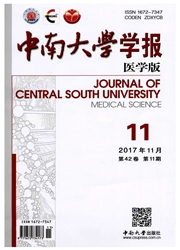

 中文摘要:
中文摘要:
目的:探讨血管紧张素(angiotensin,ang) II、醛固酮及其拮抗剂干预对大鼠心脏成纤维细胞(cardiac fibroblasts,CFs)活性和胶原蛋白表达的影响。方法:采用胶原酶II消化法、差速贴壁法、差速脱壁法获取并纯化SD乳鼠CFs,将3,4代CFs分为:ang II组、醛固酮组、ang II+醛固酮组、ang II+氯沙坦组、醛固酮+螺内酯组、对照组。采用CCK-8活细胞计数试剂盒检测细胞活性;RT-PCR检测细胞中I型胶原前胶原A1(collagen,type I,alpha 1, COL1A1)、III型胶原前胶原A1(collagen,type III,alpha 1,COL3A1)以及MMP1,基质金属蛋白酶的组织抑制剂(tissue inhibitor of metalloproteinases,TIMP1)mRNA的变化;Western印迹检测COL1A1,COL3A1,MMP1,TIMP1蛋白表达的变化。结果:与对照组比较,ang II、醛固酮可明显促进CFs增殖(增殖率分别为38.5%,28.5%;P〈0.05),ang II+醛固酮组的增殖率较ang II、醛固酮单独干预组更高(增殖率54.4%,P〈0.05),氯沙坦、螺内酯可显著抑制ang II、醛固酮诱导的细胞增殖效应(P〈0.05);与对照组比较,ang II,醛固酮可显著促进COL1A1,COL3A1,MMP1 mRNA和蛋白表达(P〈0.05),同时抑制TIMP1 mRNA和蛋白表达(P〈0.05),氯沙坦、螺内酯可显著抑制ang II、醛固酮诱导的COL1A1, COL3A1,MMP1 mRNA和蛋白表达的增加(P〈0.05),同时升高TIMP1 mRNA和蛋白表达(P〈0.05)。结论:Ang II、醛固酮可促进体外培养CFs增殖和增加I,III型胶原表达;Ang II、醛固酮同时干预时具有协同和叠加效应,而氯沙坦、螺内酯可抑制这一效应;其作用机制可能通过影响MMPs/TIMPs的平衡,使心胶原代谢紊乱,增加CFs活性,促进心纤维化。
 英文摘要:
英文摘要:
Objective:To investigate the effect of angiotensin II (ang II), aldosterone (ald) and their receptor antagonists losartan (los) and spironolactone (spi) on the proliferation and collagen production of cardiac ifbroblasts (CFs) in rats. Methods:CFs were isolated from neonatal SD rats by collagenase II method and puriifed with differential attachment and detachment method. The 3 or 4 passages of the CFs were divided into the following groups:angiotensin II, angiotensin II+aldosterone, aldosterone, angiotensin II+losartan, and aldosterone+spironolactone. The cell viability of the CFs was assessed by Cell Counting Kit-8 (CCK-8) after the drug administration. The mRNA and protein expression levels of COL1A1, COL3A1, MMP1 and TIMP1 were detected by reverse transcription polymerase chain reaction (RT-PCR) and Western blot respectively. Results:Ang II and Ald facilitated the proliferation rate of the CFs independently compared with that in the control group (38.5%vs 28.5%;P〈0.05), and the proliferation rate in the ang II+ald group was higher than that in the ang II group and ald group alone (54.4%, P〈0.05). Los and spi inhibited the effect induced by ang II and ald respectively (P〈0.05). Compared with the control group, ang II and ald signiifcantly enhanced COL1A1, COL3A1 and MMP1 expression both at the mRNA and protein levels (P〈0.05), but the TIMP1 expression was inhibited (P〈0.05), which could be abolished by corresponding receptor antagonists los and spi (P〈0.05). Conclusion:Ang II and ald can promote the proliferation of CFs, and the COL1A1 and COL3A1 expression is enhanced both at mRNA and protein levels. Ang II and ald have synergistic effect when they are used together, while los and spi may restrain the effect. The mechanism is probably linked with the balance of MMPs/TIMPs.
 同期刊论文项目
同期刊论文项目
 同项目期刊论文
同项目期刊论文
 期刊信息
期刊信息
